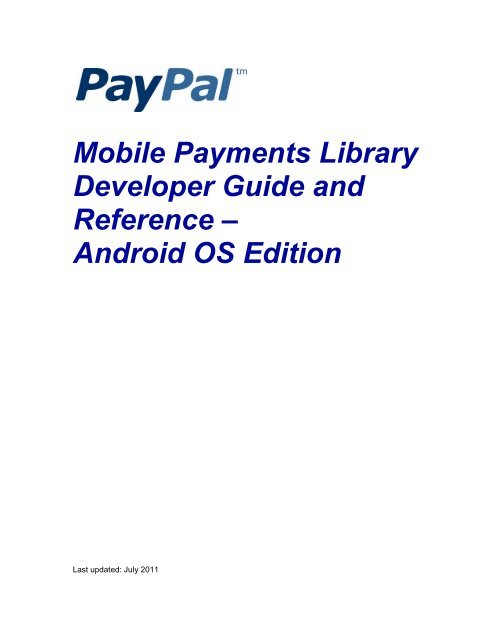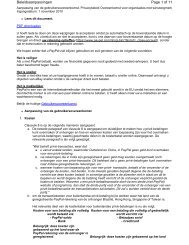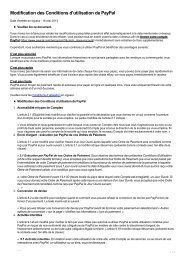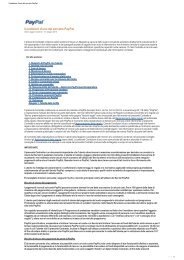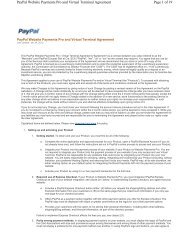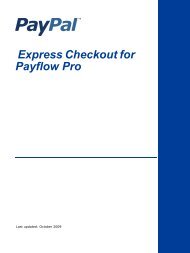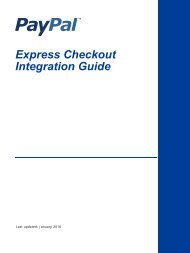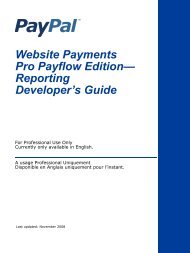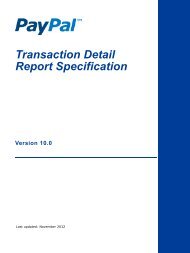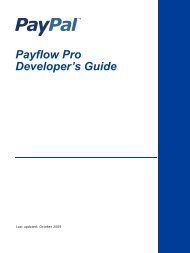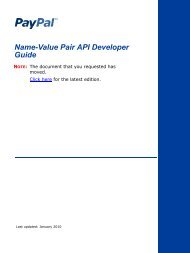Mobile Payments Library Developer Guide and Reference ... - PayPal
Mobile Payments Library Developer Guide and Reference ... - PayPal
Mobile Payments Library Developer Guide and Reference ... - PayPal
You also want an ePaper? Increase the reach of your titles
YUMPU automatically turns print PDFs into web optimized ePapers that Google loves.
<strong>Mobile</strong> <strong>Payments</strong> <strong>Library</strong><br />
<strong>Developer</strong> <strong>Guide</strong> <strong>and</strong><br />
<strong>Reference</strong> –<br />
Android OS Edition<br />
Last updated: July 2011
<strong>PayPal</strong> <strong>Mobile</strong> <strong>Payments</strong> <strong>Developer</strong> <strong>Guide</strong> <strong>and</strong> <strong>Reference</strong> – Android OS Edition<br />
Document Number 10116.en_US-201101<br />
© 2011 <strong>PayPal</strong>, Inc. All rights reserved. <strong>PayPal</strong> is a registered trademark of <strong>PayPal</strong>, Inc. The <strong>PayPal</strong> logo is a<br />
trademark of <strong>PayPal</strong>, Inc. Other trademarks <strong>and</strong> br<strong>and</strong>s are the property of their respective owners.<br />
The information in this document belongs to <strong>PayPal</strong>, Inc. It may not be used, reproduced or disclosed without the<br />
written approval of <strong>PayPal</strong>, Inc.<br />
Copyright © <strong>PayPal</strong>. All rights reserved. <strong>PayPal</strong> S.à r.l. et Cie, S.C.A., Société en Comm<strong>and</strong>ite par Actions.<br />
Registered office: 22-24 Boulevard Royal, L-2449, Luxembourg, R.C.S. Luxembourg B 118 349<br />
Consumer advisory: The <strong>PayPal</strong> payment service is regarded as a stored value facility under Singapore law. As<br />
such, it does not require the approval of the Monetary Authority of Singapore. You are advised to read the terms<br />
<strong>and</strong> conditions carefully.<br />
Notice of non-liability:<br />
<strong>PayPal</strong>, Inc. is providing the information in this document to you “AS-IS” with all faults. <strong>PayPal</strong>, Inc. makes no<br />
warranties of any kind (whether express, implied or statutory) with respect to the information contained herein.<br />
<strong>PayPal</strong>, Inc. assumes no liability for damages (whether direct or indirect), caused by errors or omissions, or<br />
resulting from the use of this document or the information contained in this document or resulting from the<br />
application or use of the product or service described herein. <strong>PayPal</strong>, Inc. reserves the right to make changes to<br />
any information herein without further notice.
Contents<br />
Preface ............................................................................................................... 5<br />
Purpose ........................................................................................................................ 5<br />
Scope ............................................................................................................................ 5<br />
OS <strong>and</strong> Hardware Support ........................................................................................... 5<br />
Revision History ............................................................................................................ 5<br />
Where to Go for More Information ................................................................................ 7<br />
1. <strong>PayPal</strong> <strong>Mobile</strong> <strong>Payments</strong> <strong>Library</strong> ............................................................... 8<br />
<strong>Mobile</strong> <strong>Payments</strong> <strong>Library</strong> API <strong>Reference</strong> ..................................................................... 8<br />
Declaring the <strong>Library</strong> <strong>and</strong> Permissions in AndroidManifest.xml ................................... 8<br />
Adding the <strong>Library</strong> Jar File <strong>and</strong> Importing Classes....................................................... 9<br />
Required Methods in the <strong>Mobile</strong> <strong>Payments</strong> <strong>Library</strong> ................................................... 10<br />
Optional Methods in the <strong>Mobile</strong> <strong>Payments</strong> <strong>Library</strong> ..................................................... 16<br />
Activity Results for the <strong>Mobile</strong> <strong>Payments</strong> <strong>Library</strong> ....................................................... 16<br />
After the Payment ....................................................................................................... 18<br />
Instant Payment Notification ................................................................................ 18<br />
Transaction Details .............................................................................................. 18<br />
Refunds ................................................................................................................ 18<br />
Simple, Parallel, <strong>and</strong> Chained <strong>Payments</strong> ................................................................... 19<br />
Preapprovals............................................................................................................... 21<br />
How Preapprovals Work ...................................................................................... 21<br />
About Preapproval Keys ...................................................................................... 21<br />
About Preapproval Pins ....................................................................................... 22<br />
Sample Call .......................................................................................................... 22<br />
Custom Objects in the <strong>Mobile</strong> <strong>Payments</strong> <strong>Library</strong> ....................................................... 23<br />
Enumerated Values in the <strong>Mobile</strong> <strong>Payments</strong> <strong>Library</strong> ................................................. 28<br />
Localization Support in the <strong>Mobile</strong> <strong>Payments</strong> <strong>Library</strong> ................................................ 29<br />
2. The Checkout Experience with the <strong>Mobile</strong> <strong>Payments</strong> <strong>Library</strong> ............... 31<br />
Checkout Experience #1 – Goods or Services with Shipping .................................... 31<br />
Checkout Experience #2 – Goods or Services without Shipping ............................... 32<br />
Checkout Experience #3 – Donations ........................................................................ 33<br />
Checkout Experience #4 – Personal Send Money <strong>Payments</strong> .................................... 34<br />
Checkout Experience #5 – Create Pin ....................................................................... 35<br />
Checkout Experience #6 – Preapproval ..................................................................... 36<br />
Basic Preapproval Checkout ................................................................................ 36<br />
Creating Preapproval PINs During Preapproval Checkout .................................. 37<br />
<strong>Mobile</strong> <strong>Payments</strong> <strong>Library</strong> <strong>Developer</strong> <strong>Guide</strong> <strong>and</strong> <strong>Reference</strong> – Android OS Edition July 2011 3
3. Submitting Your Application to <strong>PayPal</strong> ................................................... 38<br />
A. Currencies Supported by <strong>PayPal</strong> ............................................................. 39<br />
B. Countries <strong>and</strong> Regions Supported by <strong>PayPal</strong> ......................................... 41<br />
4 July 2011 <strong>PayPal</strong> <strong>Mobile</strong> <strong>Payments</strong> <strong>Developer</strong> <strong>Guide</strong> <strong>and</strong> <strong>Reference</strong> – Android OS Edition
Preface<br />
Purpose<br />
Scope<br />
The <strong>PayPal</strong> <strong>Mobile</strong> <strong>Payments</strong> library provides secure, extensible, <strong>and</strong> scalable <strong>PayPal</strong> payment<br />
functionality to the Android platform.<br />
The <strong>PayPal</strong> <strong>Mobile</strong> <strong>Payments</strong> <strong>Library</strong> provides an easy way for you to integrate payments into<br />
your Android applications. You can download the library from X.com <strong>and</strong> include it in your<br />
application. With the library, you need only a few lines of code to integrate the payments library<br />
with your application.<br />
When a buyer makes a payment, the library controls the checkout experience – logging in,<br />
reviewing, <strong>and</strong> completing the payment. After buyers complete their payments, the library returns<br />
the buyer to your application.<br />
This document describes how to integrate the <strong>PayPal</strong> <strong>Mobile</strong> <strong>Payments</strong> <strong>Library</strong> with your<br />
application. You must create <strong>and</strong> provide your build to <strong>PayPal</strong> so <strong>PayPal</strong> can review your<br />
application before it is approved to accept payments via the library. The approval process is<br />
described later in the document.<br />
OS <strong>and</strong> Hardware Support<br />
The <strong>PayPal</strong> <strong>Mobile</strong> <strong>Payments</strong> <strong>Library</strong> supports Android OS 1.5 <strong>and</strong> higher. All Android devices<br />
are supported.<br />
Revision History<br />
The following table lists revisions made to the <strong>Mobile</strong> <strong>Payments</strong> <strong>Library</strong> <strong>Developer</strong> <strong>Guide</strong> <strong>and</strong><br />
<strong>Reference</strong>.<br />
Version Date Published Description<br />
1.5.5 July 2011 Initialization is recallable <strong>and</strong> completes within 3 sec down from 20-30<br />
sec.<br />
„Keep Me Logged‟ in functionality reinstated.<br />
1.5 February 2011 Improved Tablet Support<br />
Merchant has the ability cancel transaction from dynamic amount<br />
calculation.<br />
1.1.1 January 2011 Eliminated “Keep Me Logged In” functionality<br />
<strong>Mobile</strong> <strong>Payments</strong> <strong>Library</strong> <strong>Developer</strong> <strong>Guide</strong> <strong>and</strong> <strong>Reference</strong> – Android OS Edition July 2011 5
Version Date Published Description<br />
1.1 December 2010 Added information about preapproval; dropped support for the<br />
enumeration value BUTTON_118x24<br />
1.0 September 2010 Adaptive <strong>Payments</strong> Support<br />
0.7 May 2010 First publication<br />
6 July 2011 <strong>PayPal</strong> <strong>Mobile</strong> <strong>Payments</strong> <strong>Developer</strong> <strong>Guide</strong> <strong>and</strong> <strong>Reference</strong> – Android OS Edition
Where to Go for More Information<br />
� Adaptive <strong>Payments</strong> <strong>Developer</strong> <strong>Guide</strong><br />
� S<strong>and</strong>box User <strong>Guide</strong><br />
� Merchant Setup <strong>and</strong> Administration <strong>Guide</strong><br />
� <strong>PayPal</strong> X <strong>Developer</strong> Network (x.com)<br />
<strong>Mobile</strong> <strong>Payments</strong> <strong>Library</strong> <strong>Developer</strong> <strong>Guide</strong> <strong>and</strong> <strong>Reference</strong> – Android OS Edition July 2011 7
1. <strong>PayPal</strong> <strong>Mobile</strong> <strong>Payments</strong> <strong>Library</strong><br />
This section provides details about the <strong>Mobile</strong> <strong>Payments</strong> <strong>Library</strong> API, <strong>and</strong> it provides instructions<br />
<strong>and</strong> examples for integrating the library with your Android application.<br />
<strong>Mobile</strong> <strong>Payments</strong> <strong>Library</strong> API <strong>Reference</strong><br />
The flow of the library is:<br />
1. Your application initializes the library.<br />
2. The library creates a Pay with <strong>PayPal</strong> Button <strong>and</strong> returns it to you so you can place it on<br />
the screen.<br />
3. (Optional) Your application enables Dynamic Amount Calculation (see step 4 below) to<br />
recalculate the payment amount, tax, currency, <strong>and</strong> shipping values when buyers change the<br />
shipping address for the payment.<br />
4. When buyers select the Pay with <strong>PayPal</strong> button, the library takes them through the <strong>PayPal</strong><br />
Checkout experience.<br />
5. (Optional) If you enabled dynamic amount calculation in step 1 above:<br />
a. When a buyer chooses an address for the payment, the library returns a call back to<br />
your application with the address information.<br />
b. Your application recalculates the payment <strong>and</strong> other amounts, based on the address.<br />
c. The library returns the buyer to the checkout experience, which uses the updated<br />
payment amount, tax, currency, <strong>and</strong> shipping values.<br />
6. After buyers complete their payments, the library returns a callback to your application with<br />
the status of the payment <strong>and</strong> the pay key. Note: at this time, the library is still in control of<br />
the UI <strong>and</strong> has not returned control to your application.<br />
7. After the library flow is complete, an activity result will be posted to be received by your<br />
application.<br />
Declaring the <strong>Library</strong> <strong>and</strong> Permissions in AndroidManifest.xml<br />
Since the <strong>Mobile</strong> <strong>Payments</strong> <strong>Library</strong> is an Activity, you must declare it in the<br />
AndroidManifest.xml file of your application. You must also declare Internet <strong>and</strong> Phone<br />
State permissions that the <strong>Library</strong> requires. Below is an example AndroidManifest.xml. Sections<br />
specifically relevant to the <strong>Library</strong> are in bold:<br />
<br />
<br />
<br />
<strong>and</strong>roid:label="@string/app_name"><br />
<br />
<br />
<br />
<br />
<br />
Required Methods in the <strong>Mobile</strong> <strong>Payments</strong> <strong>Library</strong><br />
initWithAppID Method<br />
The initWithAppID method creates <strong>and</strong> returns the <strong>PayPal</strong> object. You must pass in the context<br />
<strong>and</strong> the unique application ID (appID) that <strong>PayPal</strong> has provided. You can choose whether to use<br />
the live or s<strong>and</strong>box server, or use non-networked (Demo) mode (see below).<br />
static public <strong>PayPal</strong> initWithAppID(Context context, String appID, int<br />
server)<br />
An example of initializing the <strong>Library</strong> with this method is:<br />
<strong>PayPal</strong> ppObj = <strong>PayPal</strong>.initWithAppID(this.getBaseContext(), "APP-<br />
80W284485P519543T", <strong>PayPal</strong>.ENV_SANDBOX);<br />
Parameter Description<br />
context: (Required) The context.<br />
appID: (Required) <strong>PayPal</strong> Application ID from X.com.<br />
� This will be different for each server. Thus, the appID will be<br />
different for Stage <strong>and</strong> S<strong>and</strong>box. Any appID value can be used when<br />
testing on „none‟ since the library does not contact the server when<br />
set to this.<br />
server: (Required) Sets the <strong>PayPal</strong> server to Live, S<strong>and</strong>box, or None.<br />
Allowable values are:<br />
� ENV_LIVE – Use the <strong>PayPal</strong> production servers.<br />
(does not support simulators)<br />
� ENV_SANDBOX – Use the <strong>PayPal</strong> testing servers.<br />
� ENV_NONE - Do not use any <strong>PayPal</strong> servers. Operate in<br />
demonstration mode, instead. Demonstration mode lets you view<br />
various payment flows without requiring production or test accounts<br />
on <strong>PayPal</strong> servers. Network calls within the library are simulated by<br />
using demonstration data held within the library.<br />
NOTE: The initWithAppID method should only be invoked once. After initialization,<br />
reference the <strong>PayPal</strong> object using the getInstance method instead. Calling the<br />
initWithAppID method more than once will throw an IllegalStateException.<br />
NOTE: If you do not set the optional parameter forEnvironment, the library defaults to use<br />
the <strong>PayPal</strong> production the servers. When testing your application, <strong>PayPal</strong> recommends that<br />
you initialize the library to use the <strong>PayPal</strong> test servers, instead.<br />
NOTE: The <strong>Mobile</strong> <strong>Payments</strong> <strong>Library</strong> binds specific devices to specific application IDs, for<br />
enhanced security. For each of your application IDs, you must use a different s<strong>and</strong>box<br />
10 July 2011 <strong>PayPal</strong> <strong>Mobile</strong> <strong>Payments</strong> <strong>Developer</strong> <strong>Guide</strong> <strong>and</strong> <strong>Reference</strong> – Android OS Edition
account for each of your devices. If you try to login with a different account on a device<br />
after binding, you will get the following error: “This app is attached to another <strong>PayPal</strong><br />
account. To remove it, the account holder must visit <strong>PayPal</strong>.com <strong>and</strong> select <strong>Mobile</strong><br />
Applications from the profile.”<br />
To switch a device or simulator to use a different s<strong>and</strong>box account, go to the <strong>PayPal</strong><br />
S<strong>and</strong>box website on your computer, login with the account that was used on the device,<br />
select Profile > <strong>Mobile</strong> Applications, <strong>and</strong> then unbind the device from the application ID.<br />
getCheckoutButton Method<br />
You must get the Pay with <strong>PayPal</strong> payment button from the <strong>Mobile</strong> <strong>Payments</strong> <strong>Library</strong>. Use this<br />
method, which returns a CheckoutButton (a subclass of LinearLayout), which you can place<br />
in your application.<br />
public CheckoutButton getCheckoutButton(Context context, int style, int<br />
textType);<br />
Example code of getting the Payment button from the <strong>Library</strong> is:<br />
CheckoutButton launch<strong>PayPal</strong>Button = ppObj.getCheckoutButton(this,<br />
<strong>PayPal</strong>.BUTTON_278x43, CheckoutButton.TEXT_PAY);<br />
RelativeLayout.LayoutParams params = new<br />
RelativeLayout.LayoutParams(LayoutParams.WRAP_CONTENT,<br />
LayoutParams.WRAP_CONTENT);<br />
params.addRule(RelativeLayout.ALIGN_PARENT_BOTTOM);<br />
params.bottomMargin = 10;<br />
launch<strong>PayPal</strong>Button.setLayoutParams(params);<br />
launch<strong>PayPal</strong>Button.setOnClickListener(this);<br />
((RelativeLayout)findViewById(R.id.RelativeLayout01)).addView(lau<br />
nch<strong>PayPal</strong>Button);<br />
<strong>Mobile</strong> <strong>Payments</strong> <strong>Library</strong> <strong>Developer</strong> <strong>Guide</strong> <strong>and</strong> <strong>Reference</strong> – Android OS Edition July 2011 11
Parameter Description<br />
style: (Required) Size <strong>and</strong> appearance of the Pay with <strong>PayPal</strong> button<br />
Allowable values are:<br />
� <strong>PayPal</strong>.BUTTON_152x33<br />
� <strong>PayPal</strong>.BUTTON_194x37<br />
� <strong>PayPal</strong>.BUTTON_278x43<br />
� <strong>PayPal</strong>.BUTTON_294x45<br />
context: (Required) The context<br />
For images of the different button types, see “Enumerated Values in the<br />
<strong>Mobile</strong> <strong>Payments</strong> <strong>Library</strong>” on page 28.<br />
textType: (Required) The type of button to be used. The type will determine the<br />
text that is to be used on the button. This has no bearing on the payment<br />
<strong>and</strong> only affects the button itself. Allowable values are:<br />
Start the <strong>Library</strong> Activity<br />
� CheckoutButton.TEXT_PAY<br />
� CheckoutButton.TEXT_DONATE<br />
The <strong>Library</strong> uses the native Android Activity mechanism to start the checkout flow, <strong>and</strong> to<br />
communicate completion back to you. In addition to the onActivityResult callback, you can<br />
implement <strong>PayPal</strong>ResultDelegate to be informed immediately upon successful completion of<br />
a payment.<br />
To start the <strong>PayPal</strong> payment, you must start the <strong>Library</strong> activity, using the Android method<br />
startActivityForResult. Do this when buyers touch the Pay with <strong>PayPal</strong> button (which<br />
you placed on your page with the getCheckoutButton method)<br />
You must first create the <strong>PayPal</strong> intent <strong>and</strong> give it the Payment object. There are two types of<br />
payment objects. <strong>PayPal</strong>Payment h<strong>and</strong>les simple payments, which support single receivers of<br />
payments with one transaction <strong>and</strong> a few details. <strong>PayPal</strong>AdvancedPayment h<strong>and</strong>les parallel<br />
<strong>and</strong> chained payments, which support multiple receivers of payment with one transaction <strong>and</strong><br />
with additional details, such as invoice data.<br />
In the following example, the buyer checks out with a simple payment for a single recipient:<br />
<strong>PayPal</strong>Payment newPayment = new <strong>PayPal</strong>Payment();<br />
newPayment.setSubtotal(10.f);<br />
newPayment.setCurrency("USD");<br />
newPayment.setRecipient("my@email.com");<br />
newPayment.setMerchantName("My Company");<br />
Intent paypalIntent = <strong>PayPal</strong>.getInstance().checkout(newPayment, this);<br />
this.startActivityForResult(paypalIntent, 1);<br />
12 July 2011 <strong>PayPal</strong> <strong>Mobile</strong> <strong>Payments</strong> <strong>Developer</strong> <strong>Guide</strong> <strong>and</strong> <strong>Reference</strong> – Android OS Edition
In the following example, the buyer checks out with a parallel or chained payment for multiple<br />
recipients:<br />
<strong>PayPal</strong>ReceiverDetails receiver0, receiver1;<br />
receiver0 = new <strong>PayPal</strong>ReceiverDetails();<br />
…<br />
//setup receiver details<br />
…<br />
<strong>PayPal</strong>AdvancedPayment advPayment = new <strong>PayPal</strong>AdvancedPayment();<br />
advPayment.setCurrency("USD");<br />
advPayment.getReceivers().add(receiver0);<br />
advPayment.getReceivers().add(receiver1);<br />
Intent paypalIntent = <strong>PayPal</strong>.getInstance().checkout(advPayment, this);<br />
this.startActivityForResult(paypalIntent, 1);<br />
For more information on receivers <strong>and</strong> how to use them, see “Custom Objects in the <strong>Mobile</strong><br />
<strong>Payments</strong> <strong>Library</strong>” on page 23.<br />
Parameter Description<br />
intent: (Required) A <strong>PayPal</strong>Payment object that contains information<br />
about the payment. Create this intent with the following code:<br />
Intent checkoutIntent = new Intent(this,<br />
<strong>PayPal</strong>Activity.class);<br />
For the properties of this object type, see “<strong>PayPal</strong>Payment” on page<br />
24.<br />
requestCode: (Required) Use any integer for the request code. When you get the<br />
onActivityResult() callback from the <strong>Library</strong> Activity, you<br />
can use this request code to know that the results are coming from the<br />
<strong>Library</strong> activity.<br />
Note: On older devices <strong>and</strong>/or firmware, starting the activity may take significant time to<br />
complete, resulting in an “Activity is not responding” popup if the user attempts to enter input<br />
during this time. It is recommended to create a loading thread with an animation of some sort if<br />
you witness this regularly.<br />
Dynamic Amount Calculation<br />
The <strong>Mobile</strong> <strong>Payments</strong> <strong>Library</strong> allows you to modify the payment based on the buyer‟s shipping<br />
address. For instance, you might want to recalculate the tax amount based on the buyer‟s location.<br />
To enable this, use the optional method enableDynamicAmountCalculation() (see<br />
“Optional Methods” below. You must provide the logic that creates the new payment values<br />
based on the buyer‟s address. The library includes a PaymentAdjuster class for this.<br />
To use this feature, one of your classes (not an Activity) must implement “PaymentAdjuster”, as<br />
well as implement “Serializable”. For simplicity, we recommend creating a new class that does<br />
this. This class must include the following methods:<br />
<strong>Mobile</strong> <strong>Payments</strong> <strong>Library</strong> <strong>Developer</strong> <strong>Guide</strong> <strong>and</strong> <strong>Reference</strong> – Android OS Edition July 2011 13
public MEPAmounts adjustAmount(MEPAddress address, String currency,<br />
String amount, String tax, String shipping);<br />
Parameter Description<br />
address The buyer's address that should be used when calculating adjusted tax<br />
<strong>and</strong> shipping amounts.<br />
currency The currency of the payment.<br />
amount The current subtotal amount.<br />
tax The current tax amount.<br />
shipping The current shipping amount.<br />
Your method must return a new MEPAmounts object (see Custom Objects section). This object<br />
contains the new currency <strong>and</strong> amounts.<br />
public Vector adjustAmountsAdvanced(MEPAddress<br />
address, String currency, Vector receivers);<br />
Parameter Description<br />
address The buyer's address that should be used when calculating adjusted tax<br />
<strong>and</strong> shipping amounts.<br />
currency The currency of the payment.<br />
receivers A collection of current receivers <strong>and</strong> the amounts associated with each<br />
receiver.<br />
Your method must return a new Vector to update the library with<br />
adjusted amounts for each receiver. (See Custom Objects section).<br />
Applications may cancel a payment during the PaymentAdjust callback by returning 'null'.<br />
Returning null will cancel the entire payment. A dialog will be presented to the user indicating<br />
that the adjustment failed <strong>and</strong> the payment is being cancelled. Applications may also call<br />
<strong>PayPal</strong>.setAdjustPaymentError(String message) to establish the message that will be presented.<br />
Otherwise a st<strong>and</strong>ard message will be used. The error message should be established prior to<br />
failing the the payment adjust.<br />
When you create the <strong>PayPal</strong> Activity, you must pass through the PaymentAdjuster class to<br />
another form of the checkout method. For example, if you created an “AdjustAmounts” class<br />
that implements PaymentAdjuster <strong>and</strong> contains the adjustAmount method, your code could<br />
be:<br />
AdjustAmounts adjustClass = new AdjustAmounts();<br />
Intent paypalIntent = <strong>PayPal</strong>.getInstance().checkout([your payment<br />
object], this, adjustClass);<br />
this.startActivityForResult(paypalIntent, 1);<br />
14 July 2011 <strong>PayPal</strong> <strong>Mobile</strong> <strong>Payments</strong> <strong>Developer</strong> <strong>Guide</strong> <strong>and</strong> <strong>Reference</strong> – Android OS Edition
Method Sequence<br />
The following diagram illustrates the sequence of methods required to implement the checkout<br />
experience.<br />
<strong>Mobile</strong> <strong>Payments</strong> <strong>Library</strong> <strong>Developer</strong> <strong>Guide</strong> <strong>and</strong> <strong>Reference</strong> – Android OS Edition July 2011 15
Optional Methods in the <strong>Mobile</strong> <strong>Payments</strong> <strong>Library</strong><br />
getInstance Method<br />
This method returns the singleton <strong>PayPal</strong> object.<br />
<strong>PayPal</strong> payPal = <strong>PayPal</strong>.getInstance();<br />
setLanguage Method<br />
payPal.setLanguage(String emailOrPhone);<br />
Enable / Disable Shipping Method<br />
This method lets buyers include display of shipping addresses in the <strong>Library</strong>. With shipping<br />
enabled, buyers can choose an address from the list available in their <strong>PayPal</strong> accounts. The<br />
chosen shipping address is then used for the payment. Shipping is enabled by default.<br />
payPal.setShippingEnabled(boolean isEnabled);<br />
setFeesPayer Method<br />
This method is valid only for Personal payments only. Call this method to set who pays any fees,<br />
by default. If you do not call this method, the receiver pays any fees by default.<br />
payPal.setFeesPayer (int feesPayer);<br />
setDynamicAmountCalculationEnabled Method<br />
This method lets you recalculate the payment amount, tax, currency, <strong>and</strong> shipping values based<br />
on the shipping address chosen by a buyer. If you use this method to enable dynamic amount<br />
calculation before the checkout starts, the library will dynamically update the payment based on<br />
logic you provide (see above).<br />
NOTE: If shipping is not enabled, this method is ignored.<br />
payPal.setDynamicAmountCalculationEnabled(boolean enabled);<br />
Activity Results for the <strong>Mobile</strong> <strong>Payments</strong> <strong>Library</strong><br />
You will receive the payment results through the onActivityResult method. This method<br />
must be overridden in the same class in which you called startActivityForResult. There<br />
are three possible results. The first two are native Android Activity results. The third result is a<br />
custom result for the <strong>Library</strong>.<br />
In addition to these activity results, a successful payment callback is provided to note when the<br />
payment is successfully completed. These Activity results are only posted when the library<br />
Activity has terminated <strong>and</strong> control of the UI has passed back to the host Application:<br />
16 July 2011 <strong>PayPal</strong> <strong>Mobile</strong> <strong>Payments</strong> <strong>Developer</strong> <strong>Guide</strong> <strong>and</strong> <strong>Reference</strong> – Android OS Edition
Activity.RESULT_OK<br />
This result is returned when a <strong>PayPal</strong> payment succeeds. The pay key is available in the Intent<br />
data as <strong>PayPal</strong>Activity.EXTRA_PAY_KEY. The code to get the pay key as a string is:<br />
data.getStringExtra(<strong>PayPal</strong>Activity.EXTRA_PAY_KEY).<br />
Activity.RESULT_CANCELED<br />
This result is returned if the buyer cancels the payment during checkout.<br />
paymentCanceled();<br />
<strong>PayPal</strong>Activity.RESULT_FAILURE<br />
This result is returned if the payment fails for any reason other than a buyer who cancels the<br />
payment during checkout. The error id <strong>and</strong> the buyer-friendly error message are available from<br />
the Intent data as <strong>PayPal</strong>Activity.EXTRA_ERROR_ID <strong>and</strong><br />
<strong>PayPal</strong>Activity.EXTRA_ERROR_MESSAGE.<br />
Example code on h<strong>and</strong>ling the response is:<br />
@Override<br />
public void onActivityResult(int requestCode, int resultCode, Intent<br />
data) {<br />
switch(resultCode) {<br />
case Activity.RESULT_OK:<br />
//The payment succeeded<br />
String payKey =<br />
data.getStringExtra(<strong>PayPal</strong>Activity.EXTRA_PAY_KEY);<br />
//Tell the user their payment succeeded<br />
break;<br />
case Activity.RESULT_CANCELED:<br />
//The payment was canceled<br />
//Tell the user their payment was canceled<br />
break;<br />
case <strong>PayPal</strong>Activity.RESULT_FAILURE:<br />
//The payment failed -- we get the error from the<br />
EXTRA_ERROR_ID <strong>and</strong> EXTRA_ERROR_MESSAGE<br />
String errorID =<br />
data.getStringExtra(<strong>PayPal</strong>Activity.EXTRA_ERROR_ID);<br />
String errorMessage =<br />
data.getStringExtra(<strong>PayPal</strong>Activity.EXTRA_ERROR_MESSAGE);<br />
//Tell the user their payment was failed.<br />
}<br />
}<br />
For a list of error types, see “Enumerated Values in the <strong>Mobile</strong> <strong>Payments</strong> <strong>Library</strong>” on page 24.<br />
<strong>Mobile</strong> <strong>Payments</strong> <strong>Library</strong> <strong>Developer</strong> <strong>Guide</strong> <strong>and</strong> <strong>Reference</strong> – Android OS Edition July 2011 17
The interface for providing details on when a payment is completed is defined in<br />
com.paypal.<strong>and</strong>roid.MEP.<strong>PayPal</strong>ResultDelegate. This interface provides you with a way to be<br />
notified immediately when a payment has completed:<br />
public interface <strong>PayPal</strong>ResultDelegate{<br />
void onPaymentSucceeded(String payKey, String paymentStatus);<br />
void onPaymentFailed(String paymentStatus, String correlationID,<br />
String payKey, String errorID, String errorMessage);<br />
void onPaymentCanceled(String paymentStatus);<br />
}<br />
<strong>PayPal</strong> recommends that you implement this interface to be immediately informed upon the<br />
completion of a payment, rather than waiting to receive the transaction details upon the<br />
completion of the <strong>PayPal</strong> MPL Activity.<br />
After the Payment<br />
After the payment is completed, the <strong>Mobile</strong> <strong>Payments</strong> <strong>Library</strong> will return the payKey. There are<br />
also a number of other features available to you to further deal with the payment: Instant Payment<br />
Notification, Transaction Details, <strong>and</strong> Refunds.<br />
Instant Payment Notification<br />
Instant Payment Notification (IPN) is <strong>PayPal</strong>‟s message service that sends a notification when a<br />
transaction is affected. You can integrate IPN with your systems to automate <strong>and</strong> manage your<br />
back office. More details <strong>and</strong> documentation are available at: www.paypal.com/ipn<br />
Transaction Details<br />
Refunds<br />
You can integrate with the <strong>PayPal</strong> PaymentDetails API to retrieve details on a payment based on<br />
the payKey. More details <strong>and</strong> documentation are available at:<br />
https://cms.paypal.com/cms_content/US/en_US/files/developer/PP_Adaptive<strong>Payments</strong>.pdf<br />
Refunds can be supported by manual refund via the <strong>PayPal</strong> account interface or via the Refund<br />
API. More details <strong>and</strong> documentation are available at:<br />
https://cms.paypal.com/cms_content/US/en_US/files/developer/PP_Adaptive<strong>Payments</strong>.pdf<br />
18 July 2011 <strong>PayPal</strong> <strong>Mobile</strong> <strong>Payments</strong> <strong>Developer</strong> <strong>Guide</strong> <strong>and</strong> <strong>Reference</strong> – Android OS Edition
Simple, Parallel, <strong>and</strong> Chained <strong>Payments</strong><br />
Simple payments have a single recipient. Parallel <strong>and</strong> Chained payments have multiple recipients<br />
<strong>and</strong> differ in the how the payments are split.<br />
Simple <strong>Payments</strong><br />
Simple payments use the <strong>PayPal</strong>Payment object which only supports a payment to a single<br />
recipient.<br />
Parallel <strong>Payments</strong><br />
Parallel <strong>Payments</strong> allow you to make payments for any amount to any number of recipients. A<br />
parallel payment is created by making a payment with multiple recipients with no primary<br />
recipient. From the end-user's st<strong>and</strong>point, a parallel payment will affect the UI by showing the<br />
details for each recipient. Contrary to chained payments, the recipients of a parallel payment are<br />
not linked together in terms of amount.<br />
<strong>Mobile</strong> <strong>Payments</strong> <strong>Library</strong> <strong>Developer</strong> <strong>Guide</strong> <strong>and</strong> <strong>Reference</strong> – Android OS Edition July 2011 19
Chained <strong>Payments</strong><br />
A chained payment is a payment from a sender that is indirectly parallel among multiple<br />
receivers. It is an extension of a typical payment from a sender to a receiver; however, a receiver,<br />
known as the primary receiver, passes part of the payment to other receivers, who are called<br />
secondary receivers.<br />
NOTE: Chained payments require a specific permission level on the part of the API caller <strong>and</strong><br />
merchant. For information, refer to the section "Adaptive <strong>Payments</strong> Permission Levels" in the<br />
Adaptive <strong>Payments</strong> <strong>Developer</strong> <strong>Guide</strong>.<br />
You can have at most one primary receiver <strong>and</strong> from 1 to 5 secondary receivers. Chained<br />
payments are useful in cases when the primary receiver acts as an agent for other receivers. The<br />
sender deals only with the primary receiver <strong>and</strong> does not know about the secondary receivers,<br />
including how a payment is parallel among receivers. The following example shows a sender<br />
making a payment of $100:<br />
In this example, the primary receiver receives $100 from the sender‟s perspective; however, the<br />
primary receiver actually receives only $10 <strong>and</strong> passes a total of $90 to secondary receivers<br />
Receiver 2 <strong>and</strong> Receiver 3.<br />
NOTE: The scenario above is an example only <strong>and</strong> does not take <strong>PayPal</strong> fees into account.<br />
20 July 2011 <strong>PayPal</strong> <strong>Mobile</strong> <strong>Payments</strong> <strong>Developer</strong> <strong>Guide</strong> <strong>and</strong> <strong>Reference</strong> – Android OS Edition
Preapprovals<br />
The <strong>PayPal</strong> <strong>Mobile</strong> <strong>Payments</strong> <strong>Library</strong> lets you set up obtain authorization in advance from buyers<br />
for future payments to you without requiring buyers to authorize each payment individually. For<br />
example, you might use the library to establish preapproval agreements for subscriptions to<br />
mobile content, such as mobile streaming audio or video. Or, you might use the library to<br />
establish preapproval agreements for payments to gain access to higher levels of difficulty in<br />
mobile games.<br />
How Preapprovals Work<br />
There are 3 steps to setting up <strong>and</strong> using preapprovals.<br />
1. Obtain a pending preapproval key from <strong>PayPal</strong>.<br />
From your web server, send a Preapproval request to <strong>PayPal</strong> with the terms of your<br />
preapproval agreement.<br />
2. Obtain authorization from the buyer for the preapproval agreement.<br />
From your mobile application, start the <strong>Library</strong> activity by using the Android method<br />
startActivityForResult with the preapproval key <strong>and</strong> the merchant‟s name. The<br />
library launches the preapproval checkout experience <strong>and</strong> returns a confirmed<br />
preapproval key.<br />
3. Take payments from the buyer under the terms of the preapproval agreement.<br />
From your web server, send a Pay request to <strong>PayPal</strong> with the buyer‟s confirmed<br />
preapproval key.<br />
For more information about the Preapproval <strong>and</strong> Pay requests, see the Adaptive <strong>Payments</strong><br />
<strong>Developer</strong> <strong>Guide</strong>.<br />
About Preapproval Keys<br />
Preapproval keys uniquely identify preapproval your agreements. Preapproval keys that you<br />
obtain by using the Preapproval API identify your pending preapproval agreements. No buyers<br />
have yet agreed to them. Pending approval keys remain valid for 3 hours before expiring without<br />
confirmation from buyers.<br />
Call the preapprovalWithKey method to launch the preapproval checkout experience to<br />
confirm a buyer‟s agreement to a pending preapproval. If the buyer completes the preapproval<br />
checkout, the library returns a confirmed preapproval key. Maintain a record of buyers <strong>and</strong> their<br />
confirmed preapproval keys on your web server. Later on your web server, take payments from<br />
buyers by sending Pay requests with buyers‟ preapproval keys to <strong>PayPal</strong>.<br />
<strong>Mobile</strong> <strong>Payments</strong> <strong>Library</strong> <strong>Developer</strong> <strong>Guide</strong> <strong>and</strong> <strong>Reference</strong> – Android OS Edition July 2011 21
About Preapproval Pins<br />
Sample Call<br />
Confirmed preapproval keys let you take payments from buyers without requiring them to log in<br />
to <strong>PayPal</strong> to authorize payments individually. Depending on your business model, you may want<br />
to obtain consent quickly from buyers before you take individual payments. Preapproval PINs are<br />
special codes that buyers enter to authorize preapproved payments individually without logging in<br />
to <strong>PayPal</strong>.<br />
For example, you might have a mobile game that requires payment from buyers to enter a higher<br />
level of difficulty. You could take the payment, without notice, when the buyer enters the higher<br />
level. However, the buyer might dispute the payment later, despite the preapproval agreement <strong>and</strong><br />
the automatic payment notice from <strong>PayPal</strong>. Obtain a buyer‟s consent before you take the entrance<br />
fee to help improve the buying experience.<br />
Specify that you want your preapprovals to use preapproval PINs when you send Preapproval<br />
requests from your web server to <strong>PayPal</strong>. Set the PreapprovalRequest.pinType to<br />
REQUIRED. <strong>PayPal</strong> returns preapproval keys that require buyers to create preapproval PINs<br />
during preapproval checkout.<br />
Later, when you take payments by using a buyer‟s confirmed preapproval key, prompt the buyer<br />
for the preapproval PIN. Pass the buyer‟s PIN to <strong>PayPal</strong> when you send the Pay request from<br />
your web server. <strong>PayPal</strong> recommends that you display the payment reason <strong>and</strong> payment amount<br />
when you prompt buyers for their preapproval PINs.<br />
After you obtain a pending approval key, construct a <strong>PayPal</strong>Preapproval object that includes<br />
the key <strong>and</strong> the merchant‟s name. Then, use the preapprove() method to create an Intent <strong>and</strong><br />
pass it in the Android startActivityForResult() method.<br />
<strong>PayPal</strong>Preapproval preapproval = new <strong>PayPal</strong>Preapproval();<br />
preapproval.setCurrencyType("USD");<br />
preapproval.setMerchantName("Preapproval Merchant");<br />
Intent preapproveIntent = <strong>PayPal</strong>.getInstance().preapprove(preapproval,<br />
this);<br />
startActivityForResult(preapproveIntent, request);<br />
NOTE: See Activity Results for the <strong>Mobile</strong> <strong>Library</strong> for callback details.<br />
22 July 2011 <strong>PayPal</strong> <strong>Mobile</strong> <strong>Payments</strong> <strong>Developer</strong> <strong>Guide</strong> <strong>and</strong> <strong>Reference</strong> – Android OS Edition
Custom Objects in the <strong>Mobile</strong> <strong>Payments</strong> <strong>Library</strong><br />
The <strong>Mobile</strong> <strong>Payments</strong> <strong>Library</strong> includes custom objects for passing information between the<br />
library <strong>and</strong> your application during checkout. Use these objects if you enable dynamic amount<br />
calculation by calling the DynamicAmountUpdate method.<br />
MEPAddress<br />
This object is passed to your PaymentAdjuster class in the AdjustAmounts method. Use<br />
this address to update the payment amount, tax, currency, <strong>and</strong> shipping values of the payment.<br />
Then, the buyer continues to check out with the new amounts.<br />
Method Description<br />
String getStreet1() First line of the street address.<br />
String getStreet2() Second line of the street address.<br />
String getCity() Name of the city.<br />
String getState() Name of the state or province.<br />
String<br />
getPostalcode)()<br />
String<br />
getCountrycode()<br />
U.S. ZIP code or other country-specific postal code.<br />
The 2-character country code.<br />
String getCountry() The name of the country.<br />
MEPAmounts<br />
This object is returned to the <strong>Library</strong> by the AdjustAmounts method of your PaymentAdjuster<br />
class. This object contains the values for the updated payment.<br />
Property Description<br />
setCurrency(String currency) (Optional) Currency code of the amount. Defaults to USD.<br />
setPaymentAmount(String<br />
paymentAmount)<br />
or<br />
setPaymentAmount(BigDecimal<br />
paymentAmount)<br />
setTax(String tax)<br />
or<br />
setTax(BigDecimal tax)<br />
setShipping(String shipping)<br />
or<br />
setShipping(BigDecimal<br />
(Required) Amount of the payment before tax or shipping.<br />
(Optional) Tax amount associated with the item.<br />
(Optional) Shipping amount for the item<br />
<strong>Mobile</strong> <strong>Payments</strong> <strong>Library</strong> <strong>Developer</strong> <strong>Guide</strong> <strong>and</strong> <strong>Reference</strong> – Android OS Edition July 2011 23
Property Description<br />
shipping)<br />
MEPReceiverAmounts<br />
Similarly to MEPAmounts <strong>and</strong> MEPAddress, this object is used in dynamic amount calculation<br />
for advanced payments.<br />
Property Description<br />
public MEPAmounts amounts; Amounts for this receiver.<br />
public String receiver; The receiver for this amount calculation.<br />
<strong>PayPal</strong>Payment<br />
This object is passed to the library through extra data in the Intent when the <strong>Library</strong> Activity is<br />
started. This object contains all the values for a payment<br />
Method Description<br />
setCurrencyType(String<br />
currency)<br />
setSubtotal(BigDecimal<br />
amount)<br />
setRecipient(String<br />
recipient)<br />
setMerchantName(String<br />
name)<br />
setInvoiceData(<strong>PayPal</strong>Invo<br />
iceData)<br />
setCustomId(String<br />
customId)<br />
(Required) - Currency code for the payment. Defaults to USD if<br />
not set.<br />
(Required) – Subtotal for the payment.<br />
(Required) - The email address or phone number of the<br />
payment‟s recipient.<br />
(Optional) - Displayed at the top of the library screen. If not set,<br />
displays the recipient email or phone number string instead.<br />
(Optional) – The InvoiceData holds information such as tax <strong>and</strong><br />
shipping amounts as well as an optional breakdown of the items<br />
included.<br />
(Optional) – The merchant's custom ID.<br />
setIpnUrl(String IPNURL) (Optional) – The IPN URL.<br />
setDescription(String<br />
description)<br />
(Optional) - Description of the item. Defaults to “Item” if not set.<br />
setMemo(String memo) (Optional) – Note for the payment.<br />
24 July 2011 <strong>PayPal</strong> <strong>Mobile</strong> <strong>Payments</strong> <strong>Developer</strong> <strong>Guide</strong> <strong>and</strong> <strong>Reference</strong> – Android OS Edition
<strong>PayPal</strong>AdvancedPayment<br />
This object is passed to the library through extra data in the Intent when the <strong>Library</strong> Activity is<br />
started. This object contains all the values for a payment<br />
Method Description<br />
setCurrencyType(String<br />
currency)<br />
setReceivers(ArrayList<br />
receivers)<br />
or<br />
getReceivers()<br />
setIpnUrl(String IPNRUL) (Optional) – The IPN URL<br />
(Required) - Currency code for the payment. Defaults to USD if<br />
not set.<br />
(Required) – Your payment must have at minimum one receiver.<br />
The receiver itself should be set up before adding it to the<br />
payment. See Receiver below for more details.<br />
The getReceivers() call can be used to alter the current ArrayList.<br />
setMemo(String memo) (Optional) – Note for the payment.<br />
<strong>Mobile</strong> <strong>Payments</strong> <strong>Library</strong> <strong>Developer</strong> <strong>Guide</strong> <strong>and</strong> <strong>Reference</strong> – Android OS Edition July 2011 25
<strong>PayPal</strong>Preapproval<br />
This object is passed to the library through extra data in the Intent when the <strong>Library</strong> Activity is<br />
started. This object contains all the values for a payment<br />
Method Description<br />
setCurrencyType(String<br />
currency)<br />
(Required) - Currency code for the payment. Defaults to USD if<br />
not set.<br />
setType(int type) (Optional) – The type of button to display, either TYPE_AGREE<br />
or TYPE_AGREE_AND_PAY. Defaults to<br />
TYPE_AGREE_ANDPAY.<br />
setIpnUrl(String IPNRUL) (Optional) – The IPN URL<br />
setMemo(String memo) (Optional) – Note for the payment.<br />
<strong>PayPal</strong>InvoiceData<br />
This is an optional object to be set for any receiver. The <strong>PayPal</strong>Payment (simple payment) has<br />
only one receiver <strong>and</strong> the InvoiceData is added directly to the payment object itself. The<br />
<strong>PayPal</strong>AdvancedPayment can support multiple receivers, each of which can have an invoice data<br />
added to it.<br />
While InvoiceData is an optional parameter for any given receiver, once added the InvoiceData<br />
must be populated with certain required parameters (see below).<br />
Method Description<br />
setTax(BigDecimal<br />
shipping)<br />
setShipping(BigDecimal<br />
shipping)<br />
setInvoiceItems(ArrayList<br />
<br />
items)<br />
(Required) – Tax amount to be used for the payment. This can be<br />
updated after the checkout flow has been started if dynamic<br />
amount calculation is enabled. The amount can be 0.<br />
(Required) – Shipping amount to be used for the payment. This<br />
can be updated after the checkout flow has been started if<br />
dynamic amount calculation is enabled. The amount can be 0.<br />
(Required) – Sets the list of items in the invoice. See InvoiceItem<br />
below for more details.��These items do not affect the total<br />
amount of the payment but must equal the subtotal.<br />
26 July 2011 <strong>PayPal</strong> <strong>Mobile</strong> <strong>Payments</strong> <strong>Developer</strong> <strong>Guide</strong> <strong>and</strong> <strong>Reference</strong> – Android OS Edition
<strong>PayPal</strong>InvoiceItem<br />
These items can be added to any InvoiceData.<br />
NOTE: The UnitPrice <strong>and</strong> Quantity must multiply together correctly to equal the<br />
TotalPrice. The TotalPrices of all invoiceItems of a <strong>PayPal</strong>Payment or a<br />
<strong>PayPal</strong>AdvancedPayment must equal the subtotal of the payment.<br />
Method Description<br />
setName(String name) (Optional) – The name of the item.<br />
setID(String ID) (Optional) – A unique ID for the item.<br />
setTotalPrice(BigDecimal<br />
price)<br />
setUnitPrice(BigDecimal<br />
price)<br />
(Requiredl) – The total cost of this item (unit cost * quantity).<br />
(Required) – The cost of a single unit of this item.<br />
setQuantity(int qty) (Required) – The quantity of this item.<br />
<strong>PayPal</strong>ReceiverDetails<br />
This object is used in the <strong>PayPal</strong>AdvancePayment to identify a single recipient.<br />
Method Description<br />
setRecipient(String<br />
recipient)<br />
setSubtotal(BigDecimal<br />
amount)<br />
setIsPrimary(boolean<br />
isPrimary)<br />
setPaymentType(int<br />
paymentType)<br />
setPaymentSubType(int<br />
paymentSubtype)<br />
setInvoiceData(<strong>PayPal</strong>Invo<br />
iceData invoice)<br />
(Required) – The email address or phone number of this recipient.<br />
(Required) – The subtotal of the payment to this recipient.<br />
(Optional) – Whether or not the receiver is a the primary receiver<br />
of the payment. A payment with multiple recipients may specify<br />
the primary recipient of the payment to denote a chained<br />
payment. <strong>Payments</strong> with multiple recipients but no primary<br />
receivers are parallel payments. See the section “Chained,<br />
Parallel, <strong>and</strong> Simple <strong>Payments</strong>” for more details.<br />
(Optional) – If this value is not set, the value passed into<br />
getPaymentButton() will be used instead.<br />
(Optional) – If this value is not set, the value passed into<br />
getPaymentButton() will be used instead.<br />
(Optional) – The InvoiceData holds information such as tax <strong>and</strong><br />
shipping amounts as well as an optional breakdown of the items<br />
included. See InvoiceData above for more details.<br />
setCustomID(String ID) (Optional) – The recipient's custom ID.<br />
setMerchantName(String<br />
name)<br />
(Optional) - Displayed at the top of the library screen. If not set,<br />
displays the recipient email or phone number string instead.<br />
<strong>Mobile</strong> <strong>Payments</strong> <strong>Library</strong> <strong>Developer</strong> <strong>Guide</strong> <strong>and</strong> <strong>Reference</strong> – Android OS Edition July 2011 27
Enumerated Values in the <strong>Mobile</strong> <strong>Payments</strong> <strong>Library</strong><br />
The enumerated values supported by various methods in the library are:<br />
PAYPAL_ENVIRONMENT<br />
� ENV_LIVE: Use the <strong>PayPal</strong> production servers<br />
� ENV_SANDBOX: Use the <strong>PayPal</strong> testing servers<br />
� ENV_NONE: Do not use any <strong>PayPal</strong> servers. Operate in demonstration mode, instead.<br />
Demonstration mode lets you view various payment flows without requiring production or<br />
test accounts on <strong>PayPal</strong> servers. Network calls within the library are simulated by using<br />
demonstration data held within the library.<br />
NOTE: ENV_LIVE does not support simulators.<br />
PAYPAL_BUTTON_TYPE<br />
BUTTON_152x33<br />
BUTTON_194x37<br />
BUTTON_278x43<br />
BUTTON_294x45<br />
NOTE: If the buttonTextType parameter is set to 'TEXT_DONATE,‟ the word “Pay” in the<br />
above buttons is replaced by “Donate.” The language of the button will also change based<br />
on the language you pass into the setLang method or the auto detected language on the<br />
phone.<br />
<strong>PayPal</strong>PaymentType<br />
PAYMENT_TYPE_HARD_GOODS<br />
PAYMENT_TYPE_SERVICE<br />
PAYMENT_TYPE_PERSONAL<br />
NOTE: For Personal payment types, the <strong>PayPal</strong> Checkout experience differs slightly from other<br />
payment types. Additionally for Personal payment types, senders in some cases can<br />
28 July 2011 <strong>PayPal</strong> <strong>Mobile</strong> <strong>Payments</strong> <strong>Developer</strong> <strong>Guide</strong> <strong>and</strong> <strong>Reference</strong> – Android OS Edition
choose who pays any fees – the sender or the recipient. In India <strong>and</strong> Germany, recipients<br />
always pay any fees.<br />
For more information, see “setFeesPayer Method” on page 16.<br />
PAYPAL_FAILURE<br />
SYSTEM_ERROR<br />
RECIPIENT_ERROR<br />
APPLICATION_ERROR<br />
CONSUMER_ERROR<br />
These failures are returned by the <strong>PayPal</strong>Activity.RESULT_FAILURE result from the <strong>PayPal</strong><br />
<strong>Library</strong> activity.<br />
Localization Support in the <strong>Mobile</strong> <strong>Payments</strong> <strong>Library</strong><br />
To change the language in the <strong>Library</strong>, call setLanguage(String localeCode) on the<br />
<strong>PayPal</strong> object. Pass through the desired locale code (e.g. for US English, use en_US). If you do<br />
not use this method, the <strong>Library</strong> defaults to the locale to which the device is set.<br />
The <strong>Library</strong> supports the following regions:<br />
Language (Country or Region) Locale Code<br />
Chinese (Hong Kong) zh_HK<br />
Chinese (Taiwan) zh_TW<br />
Dutch (Belgium) nl_BE<br />
Dutch (Netherl<strong>and</strong>s) nl_NL<br />
English (Australia) en_AU<br />
English (Belgium) en_BE<br />
English (Canada) en_CA<br />
English (France) en_FR<br />
English (Germany) en_DE<br />
English (Great Britain) en_GB<br />
English (Hong Kong) en_HK<br />
English (India) en_IN<br />
English (Japan) en_JP<br />
English (Mexico) en_MX<br />
English (Netherl<strong>and</strong>s) en_NL<br />
English (Pol<strong>and</strong>) en_PL<br />
English (Singapore) en_SG<br />
<strong>Mobile</strong> <strong>Payments</strong> <strong>Library</strong> <strong>Developer</strong> <strong>Guide</strong> <strong>and</strong> <strong>Reference</strong> – Android OS Edition July 2011 29
Language (Country or Region) Locale Code<br />
English (Spain) en_ES<br />
English (Switzerl<strong>and</strong>) en_CH<br />
English (Taiwan) en_TW<br />
English (United States) en_US<br />
French (Belgium) fr_BE<br />
French (Canada) fr_CA<br />
French (France) fr_FR<br />
French (Switzerl<strong>and</strong>) fr_CH<br />
German (Austria) de_AT<br />
German (Germany) de_DE<br />
German (Switzerl<strong>and</strong>) de_CH<br />
Italian (Italy) it_IT<br />
Japanese (Japan) ja_JP<br />
Spanish (Argentina) es_AR<br />
Spanish (Mexico) es_MX<br />
Spanish (Spain) es_ES<br />
Polish (Pol<strong>and</strong>) pl_PL<br />
Portuguese (Brazil) pt_BR<br />
30 July 2011 <strong>PayPal</strong> <strong>Mobile</strong> <strong>Payments</strong> <strong>Developer</strong> <strong>Guide</strong> <strong>and</strong> <strong>Reference</strong> – Android OS Edition
2. The Checkout Experience with the <strong>Mobile</strong><br />
<strong>Payments</strong> <strong>Library</strong><br />
The following screen shots illustrate several different <strong>PayPal</strong> Checkout experiences that occur<br />
after buyers click the <strong>PayPal</strong> button that your application obtains from the library by using the<br />
get<strong>PayPal</strong>Button()method.<br />
Checkout Experience #1 – Goods or Services with Shipping<br />
Payment type=Hard Goods or Services / Shipping=enabled<br />
In the preceding experience, buyers enter their <strong>PayPal</strong> log-in credentials in the Log In To <strong>PayPal</strong><br />
screen. Then, they can review details of the payment in the second screen <strong>and</strong> change funding<br />
source or shipping address. If satisfied, buyers click Pay to complete the payment.<br />
<strong>Mobile</strong> <strong>Payments</strong> <strong>Library</strong> <strong>Developer</strong> <strong>Guide</strong> <strong>and</strong> <strong>Reference</strong> – Android OS Edition July 2011 31
Checkout Experience #2 – Goods or Services without Shipping<br />
Payment type=Hard Goods or Services / Shipping=disabled<br />
In the case, shipping is not required (i.e. manual pick up of goods or services). Shipping is<br />
disabled by a call to the setShippingEnabled() library method. Buyers enter their <strong>PayPal</strong><br />
log-in credentials <strong>and</strong> directly pay by clicking the Pay button on the first screen. Buyers can<br />
review funding choices by clicking the Review button on the same page.<br />
32 July 2011 <strong>PayPal</strong> <strong>Mobile</strong> <strong>Payments</strong> <strong>Developer</strong> <strong>Guide</strong> <strong>and</strong> <strong>Reference</strong> – Android OS Edition
Checkout Experience #3 – Donations<br />
Payment type=Donations / Shipping=enabled<br />
In the preceding experience, buyers make a donation to a charity or other cause. In this context<br />
the charity or cause wants to leverage <strong>PayPal</strong> members‟ addresses as mailing addresses for<br />
donation receipts. By enabling shipping in the library, buyers are presented with their primary<br />
mailing address can choose another mailing address from the ones in their <strong>PayPal</strong> accounts.<br />
<strong>Mobile</strong> <strong>Payments</strong> <strong>Library</strong> <strong>Developer</strong> <strong>Guide</strong> <strong>and</strong> <strong>Reference</strong> – Android OS Edition July 2011 33
Checkout Experience #4 – Personal Send Money <strong>Payments</strong><br />
Payment type=Personal payments / Shipping=disabled<br />
In the preceding experience, <strong>PayPal</strong> members make personal payments to other <strong>PayPal</strong> members.<br />
There are no transaction fees when it is funded by <strong>PayPal</strong> balance or by a bank account on file.<br />
The transaction carries a fee when it is funded by payment card – debit or credit or <strong>PayPal</strong> Credit<br />
cards. In some cases, senders choose who pays any fees – sender or recipient. In India <strong>and</strong><br />
Germany, recipients always pay any fees.<br />
For more information on <strong>PayPal</strong> Send Money <strong>and</strong> pricing, refer to:<br />
https://cms.paypal.com/us/cgi-bin/?cmd=_rendercontent&content_ID=marketing_us/send_money<br />
34 July 2011 <strong>PayPal</strong> <strong>Mobile</strong> <strong>Payments</strong> <strong>Developer</strong> <strong>Guide</strong> <strong>and</strong> <strong>Reference</strong> – Android OS Edition
Checkout Experience #5 – Create Pin<br />
In the preceding experience, a <strong>PayPal</strong> member has just completed a payment <strong>and</strong> does not<br />
currently have a PIN associated with his/her account. By following the on-screen instructions,<br />
the user can associate his/her account with a phone number <strong>and</strong> PIN for easier login in the future.<br />
Upon successful creation of the PIN, the user will be returned to your application triggering the<br />
paymentSuccess() delegate callback.<br />
<strong>Mobile</strong> <strong>Payments</strong> <strong>Library</strong> <strong>Developer</strong> <strong>Guide</strong> <strong>and</strong> <strong>Reference</strong> – Android OS Edition July 2011 35
Checkout Experience #6 – Preapproval<br />
In this experience, you started the Android Activity with the preapproval intent, as discussed<br />
under “Preapprovals” on page 21.<br />
Basic Preapproval Checkout<br />
Login Screen Agree <strong>and</strong> Pay Screen<br />
During a preapproval checkout, the buyer agrees to the terms of a preapproval agreement. The<br />
agreement authorizes you to take payments without requiring the buyer to log in to <strong>PayPal</strong> to<br />
authorize the payments individually. After the buyer completes the checkout, <strong>PayPal</strong> returns the<br />
buyer‟s confirmed preapproval key to your mobile application.<br />
Use the buyer‟s confirmed preapproval key to take the preapproved payments. The library does<br />
not take the payments for you. After UI control returns to your mobile application, store the<br />
buyer‟s preapproval key on you web server. Then, take your first preapproved payment by<br />
sending a Pay request with the buyer‟s preapproval key from your web server to <strong>PayPal</strong>.<br />
36 July 2011 <strong>PayPal</strong> <strong>Mobile</strong> <strong>Payments</strong> <strong>Developer</strong> <strong>Guide</strong> <strong>and</strong> <strong>Reference</strong> – Android OS Edition
Creating Preapproval PINs During Preapproval Checkout<br />
Depending on your business model, you may require buyers to create preapproval PINs during<br />
preapproval checkout. Preapproval PINs are special codes that buyers specify during checkout to<br />
let them consent quickly later to individual payments. If your preapproval agreements require<br />
PINs, <strong>PayPal</strong> displays the optional “Create a Code” screen during preapproval checkout.<br />
Login Screen Create a Code Screen Agree <strong>and</strong> Pay Screen<br />
After logging in to <strong>PayPal</strong>, the buyer enters a code that only the buyer <strong>and</strong> <strong>PayPal</strong> know. Later,<br />
before you take a preapproved payment, prompt the buyer to enter the preapproval PIN. Then<br />
from your web server, include the PIN that the buyer entered with the Pay request that you send<br />
to <strong>PayPal</strong>. <strong>PayPal</strong> recommends that you display the payment reason <strong>and</strong> payment amount when<br />
you prompt the buyer for the preapproval PIN.<br />
<strong>Mobile</strong> <strong>Payments</strong> <strong>Library</strong> <strong>Developer</strong> <strong>Guide</strong> <strong>and</strong> <strong>Reference</strong> – Android OS Edition July 2011 37
3. Submitting Your Application to <strong>PayPal</strong><br />
Before you distribute your mobile application publicly, you need an authorized application ID<br />
from <strong>PayPal</strong>. <strong>PayPal</strong> tests all mobile applications before issuing application IDs. Test your mobile<br />
application thoroughly in the <strong>PayPal</strong> S<strong>and</strong>box by using APP-80W284485P519543T as your test<br />
application ID. Then, submit your test application to <strong>PayPal</strong>.<br />
1. Log in or sign up on <strong>PayPal</strong>‟s developer website, x.com.<br />
2. After logging in successfully, click the “My Apps” tab.<br />
3. Click SUBMIT NEW APP.<br />
4. Fill in the 2-page “Submit New App” form.<br />
If you need more time, you can save your form as a draft <strong>and</strong> return later to complete it.<br />
5. Click Submit.<br />
Result:<br />
For those using simple or parallel payments, <strong>PayPal</strong> reviews your application within 24 hours<br />
<strong>and</strong> responds by sending you your <strong>PayPal</strong>ApplicationID. Reviewers at <strong>PayPal</strong> follow up<br />
by email with questions, should they arise, before they approve your mobile application. For<br />
those using chained payments or preapprovals, the review may take longer.<br />
After completing this task:<br />
Wait until <strong>PayPal</strong> sends you your application ID. Then, make sure that you update your<br />
software with the following changes before you submit your mobile application to Apple:<br />
� Application ID: in your calls to initWithApplicationId<br />
� Environment: in your calls to initWithApplicationId<br />
� Recipient: in the <strong>PayPal</strong>Payment object<br />
38 July 2011 <strong>PayPal</strong> <strong>Mobile</strong> <strong>Payments</strong> <strong>Developer</strong> <strong>Guide</strong> <strong>and</strong> <strong>Reference</strong> – Android OS Edition
A. Currencies Supported by <strong>PayPal</strong><br />
<strong>PayPal</strong> uses 3-character ISO-4217 codes for specifying currencies in fields <strong>and</strong> variables.<br />
Currency Currency Code<br />
Australian Dollar AUD<br />
Brazilian Real<br />
NOTE:This currency is supported as a payment currency<br />
<strong>and</strong> a currency balance for in-country <strong>PayPal</strong><br />
accounts only.<br />
<strong>Mobile</strong> <strong>Payments</strong> <strong>Library</strong> <strong>Developer</strong> <strong>Guide</strong> <strong>and</strong> <strong>Reference</strong> – Android OS Edition July 2011 39<br />
BRL<br />
Canadian Dollar CAD<br />
Czech Koruna CZK<br />
Danish Krone DKK<br />
Euro EUR<br />
Hong Kong Dollar HKD<br />
Hungarian Forint HUF<br />
Israeli New Shekel ILS<br />
Japanese Yen JPY<br />
Malaysian Ringgit<br />
NOTE:This currency is supported as a payment currency<br />
<strong>and</strong> a currency balance for in-country <strong>PayPal</strong><br />
accounts only.<br />
MYR<br />
Mexican Peso MXN<br />
Norwegian Krone NOK<br />
New Zeal<strong>and</strong> Dollar NZD<br />
Philippine Peso PHP<br />
Polish Zloty PLN<br />
Pound Sterling GBP<br />
Singapore Dollar SGD<br />
Swedish Krona SEK<br />
Swiss Franc CHF<br />
Taiwan New Dollar TWD<br />
Thai Baht THB<br />
U.S. Dollar USD
40 July 2011 <strong>PayPal</strong> <strong>Mobile</strong> <strong>Payments</strong> <strong>Developer</strong> <strong>Guide</strong> <strong>and</strong> <strong>Reference</strong> – Android OS Edition
B. Countries <strong>and</strong> Regions Supported by<br />
<strong>PayPal</strong><br />
<strong>PayPal</strong> uses 2-character IS0-3166-1 codes for specifying countries <strong>and</strong> regions that are supported<br />
in fields <strong>and</strong> variables.<br />
Country or Region Country or Region Code<br />
AFGHANISTAN AF<br />
ÅLAND ISLANDS AX<br />
ALBANIA AL<br />
ALGERIA DZ<br />
AMERICAN SAMOA AS<br />
ANDORRA AD<br />
ANGOLA AO<br />
ANGUILLA AI<br />
ANTARCTICA AQ<br />
ANTIGUA AND BARBUDA AG<br />
ARGENTINA AR<br />
ARMENIA AM<br />
ARUBA AW<br />
AUSTRALIA AU<br />
AUSTRIA AT<br />
AZERBAIJAN AZ<br />
BAHAMAS BS<br />
BAHRAIN BH<br />
BANGLADESH BD<br />
BARBADOS BB<br />
BELARUS BY<br />
BELGIUM BE<br />
BELIZE BZ<br />
BENIN BJ<br />
BERMUDA BM<br />
BHUTAN BT<br />
BOLIVIA BO<br />
BOSNIA AND HERZEGOVINA BA<br />
BOTSWANA BW<br />
BOUVET ISLAND BV<br />
BRAZIL BR<br />
<strong>Mobile</strong> <strong>Payments</strong> <strong>Library</strong> <strong>Developer</strong> <strong>Guide</strong> <strong>and</strong> <strong>Reference</strong> – Android OS Edition July 2011 41
Country or Region Country or Region Code<br />
BRITISH INDIAN OCEAN TERRITORY IO<br />
BRUNEI DARUSSALAM BN<br />
BULGARIA BG<br />
BURKINA FASO BF<br />
BURUNDI BI<br />
CAMBODIA KH<br />
CAMEROON CM<br />
CANADA CA<br />
CAPE VERDE CV<br />
CAYMAN ISLANDS KY<br />
CENTRAL AFRICAN REPUBLIC CF<br />
CHAD TD<br />
CHILE CL<br />
CHINA CN<br />
CHRISTMAS ISLAND CX<br />
COCOS (KEELING) ISLANDS CC<br />
COLOMBIA CO<br />
COMOROS KM<br />
CONGO CG<br />
CONGO, THE DEMOCRATIC REPUBLIC OF CD<br />
COOK ISLANDS CK<br />
COSTA RICA CR<br />
COTE D'IVOIRE CI<br />
CROATIA HR<br />
CUBA CU<br />
CYPRUS CY<br />
CZECH REPUBLIC CZ<br />
DENMARK DK<br />
DJIBOUTI DJ<br />
DOMINICA DM<br />
DOMINICAN REPUBLIC DO<br />
ECUADOR EC<br />
EGYPT EG<br />
EL SALVADOR SV<br />
EQUATORIAL GUINEA GQ<br />
ERITREA ER<br />
ESTONIA EE<br />
ETHIOPIA ET<br />
FALKLAND ISLANDS (MALVINAS) FK<br />
42 July 2011 <strong>PayPal</strong> <strong>Mobile</strong> <strong>Payments</strong> <strong>Developer</strong> <strong>Guide</strong> <strong>and</strong> <strong>Reference</strong> – Android OS Edition
Country or Region Country or Region Code<br />
FAROE ISLANDS FO<br />
FIJI FJ<br />
FINLAND FI<br />
FRANCE FR<br />
FRENCH GUIANA GF<br />
FRENCH POLYNESIA PF<br />
FRENCH SOUTHERN TERRITORIES TF<br />
GABON GA<br />
GAMBIA GM<br />
GEORGIA GE<br />
GERMANY DE<br />
GHANA GH<br />
GIBRALTAR GI<br />
GREECE GR<br />
GREENLAND GL<br />
GRENADA GD<br />
GUADELOUPE GP<br />
GUAM GU<br />
GUATEMALA GT<br />
GUERNSEY GG<br />
GUINEA GN<br />
GUINEA-BISSAU GW<br />
GUYANA GY<br />
HAITI HT<br />
HEARD ISLAND AND MCDONALD ISLANDS HM<br />
HOLY SEE (VATICAN CITY STATE) VA<br />
HONDURAS HN<br />
HONG KONG HK<br />
HUNGARY HU<br />
ICELAND IS<br />
INDIA IN<br />
INDONESIA ID<br />
IRAN, ISLAMIC REPUBLIC OF IR<br />
IRAQ IQ<br />
IRELAND IE<br />
ISLE OF MAN IM<br />
ISRAEL IL<br />
ITALY IT<br />
JAMAICA JM<br />
<strong>Mobile</strong> <strong>Payments</strong> <strong>Library</strong> <strong>Developer</strong> <strong>Guide</strong> <strong>and</strong> <strong>Reference</strong> – Android OS Edition July 2011 43
Country or Region Country or Region Code<br />
JAPAN JP<br />
JERSEY JE<br />
JORDAN JO<br />
KAZAKHSTAN KZ<br />
KENYA KE<br />
KIRIBATI KI<br />
KOREA, DEMOCRATIC PEOPLE'S REPUBLIC OF KP<br />
KOREA, REPUBLIC OF KR<br />
KUWAIT KW<br />
KYRGYZSTAN KG<br />
LAO PEOPLE'S DEMOCRATIC REPUBLIC LA<br />
LATVIA LV<br />
LEBANON LB<br />
LESOTHO LS<br />
LIBERIA LR<br />
LIBYAN ARAB JAMAHIRIYA LY<br />
LIECHTENSTEIN LI<br />
LITHUANIA LT<br />
LUXEMBOURG LU<br />
MACAO MO<br />
MACEDONIA, THE FORMER YUGOSLAV<br />
REPUBLIC OF<br />
MK<br />
MADAGASCAR MG<br />
MALAWI MW<br />
MALAYSIA MY<br />
MALDIVES MV<br />
MALI ML<br />
MALTA MT<br />
MARSHALL ISLANDS MH<br />
MARTINIQUE MQ<br />
MAURITANIA MR<br />
MAURITIUS MU<br />
MAYOTTE YT<br />
MEXICO MX<br />
MICRONESIA, FEDERATED STATES OF FM<br />
MOLDOVA, REPUBLIC OF MD<br />
MONACO MC<br />
MONGOLIA MN<br />
MONTSERRAT MS<br />
MOROCCO MA<br />
44 July 2011 <strong>PayPal</strong> <strong>Mobile</strong> <strong>Payments</strong> <strong>Developer</strong> <strong>Guide</strong> <strong>and</strong> <strong>Reference</strong> – Android OS Edition
Country or Region Country or Region Code<br />
MOZAMBIQUE MZ<br />
MYANMAR MM<br />
NAMIBIA NA<br />
NAURU NR<br />
NEPAL NP<br />
NETHERLANDS NL<br />
NETHERLANDS ANTILLES AN<br />
NEW CALEDONIA NC<br />
NEW ZEALAND NZ<br />
NICARAGUA NI<br />
NIGER NE<br />
NIGERIA NG<br />
NIUE NU<br />
NORFOLK ISLAND NF<br />
NORTHERN MARIANA ISLANDS MP<br />
NORWAY NO<br />
OMAN OM<br />
PAKISTAN PK<br />
PALAU PW<br />
PALESTINIAN TERRITORY, OCCUPIED PS<br />
PANAMA PA<br />
PAPUA NEW GUINEA PG<br />
PARAGUAY PY<br />
PERU PE<br />
PHILIPPINES PH<br />
PITCAIRN PN<br />
POLAND PL<br />
PORTUGAL PT<br />
PUERTO RICO PR<br />
QATAR QA<br />
REUNION RE<br />
ROMANIA RO<br />
RUSSIAN FEDERATION RU<br />
RWANDA RW<br />
SAINT HELENA SH<br />
SAINT KITTS AND NEVIS KN<br />
SAINT LUCIA LC<br />
SAINT PIERRE AND MIQUELON PM<br />
SAINT VINCENT AND THE GRENADINES VC<br />
<strong>Mobile</strong> <strong>Payments</strong> <strong>Library</strong> <strong>Developer</strong> <strong>Guide</strong> <strong>and</strong> <strong>Reference</strong> – Android OS Edition July 2011 45
Country or Region Country or Region Code<br />
SAMOA WS<br />
SAN MARINO SM<br />
SAO TOME AND PRINCIPE ST<br />
SAUDI ARABIA SA<br />
SENEGAL SN<br />
SERBIA AND MONTENEGRO CS<br />
SEYCHELLES SC<br />
SIERRA LEONE SL<br />
SINGAPORE SG<br />
SLOVAKIA SK<br />
SLOVENIA SI<br />
SOLOMON ISLANDS SB<br />
SOMALIA SO<br />
SOUTH AFRICA ZA<br />
SOUTH GEORGIA AND THE SOUTH SANDWICH GS<br />
ISLANDS<br />
SPAIN ES<br />
SRI LANKA LK<br />
SUDAN SD<br />
SURINAME SR<br />
SVALBARD AND JAN MAYEN SJ<br />
SWAZILAND SZ<br />
SWEDEN SE<br />
SWITZERLAND CH<br />
SYRIAN ARAB REPUBLIC SY<br />
TAIWAN, PROVINCE OF CHINA TW<br />
TAJIKISTAN TJ<br />
TANZANIA, UNITED REPUBLIC OF TZ<br />
THAILAND TH<br />
TIMOR-LESTE TL<br />
TOGO TG<br />
TOKELAU TK<br />
TONGA TO<br />
TRINIDAD AND TOBAGO TT<br />
TUNISIA TN<br />
TURKEY TR<br />
TURKMENISTAN TM<br />
TURKS AND CAICOS ISLANDS TC<br />
TUVALU TV<br />
UGANDA UG<br />
46 July 2011 <strong>PayPal</strong> <strong>Mobile</strong> <strong>Payments</strong> <strong>Developer</strong> <strong>Guide</strong> <strong>and</strong> <strong>Reference</strong> – Android OS Edition
Country or Region Country or Region Code<br />
UKRAINE UA<br />
UNITED ARAB EMIRATES AE<br />
UNITED KINGDOM GB<br />
UNITED STATES US<br />
UNITED STATES MINOR OUTLYING ISLANDS UM<br />
URUGUAY UY<br />
UZBEKISTAN UZ<br />
VANUATU VU<br />
VENEZUELA VE<br />
VIET NAM VN<br />
VIRGIN ISLANDS, BRITISH VG<br />
VIRGIN ISLANDS, U.S. VI<br />
WALLIS AND FUTUNA WF<br />
WESTERN SAHARA EH<br />
YEMEN YE<br />
ZAMBIA ZM<br />
ZIMBABWE ZW<br />
<strong>Mobile</strong> <strong>Payments</strong> <strong>Library</strong> <strong>Developer</strong> <strong>Guide</strong> <strong>and</strong> <strong>Reference</strong> – Android OS Edition July 2011 47
48 July 2011 <strong>PayPal</strong> <strong>Mobile</strong> <strong>Payments</strong> <strong>Developer</strong> <strong>Guide</strong> <strong>and</strong> <strong>Reference</strong> – Android OS Edition


